The garbage sweeper body constitutes the skeleton of the engine and is the foundation for installation of various engine mechanisms and systems. The main components and attachments of the engine are mounted inside and outside and are subjected to various loads. Therefore, the body must have sufficient strength and stiffness. The sweeper body consists of cylinder blocks, crankcases, cylinder heads and cylinder heads. A. The cylinder block (Figure 2-1) II. Crankcase Three. Cylinder head (Figure 2-7) Four cylinder head gasket (Figure 2-9) To obtain perfect joins, inside of the solder ring copper fitting and the outside of the copper pipe are cleaned using coarse steel wool, flux paste is applied, the pipe is then inserted into the fitting and heat applied from a portable propane torch until a ring of solder shows at the edges of the fitting. Sizes we have available are from 8mm to 54mm For EN1254-1 and 1/2" to 2" for ASME B16.22 ,solder ring Copper Fittings,presolder copper fittings,yorkshire copper fittings,pegler copper fittings,connex copper fittings solder ring copper fittings,presolder copper fittings,yorkshire copper fittings,pegler copper fittings,connex copper fittings Taizhou Runde Company , https://www.nerausmotor.com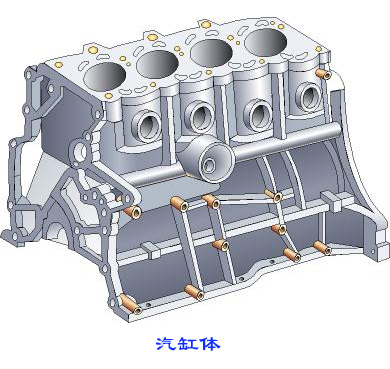
The cylinder block of the water-cooled engine and the upper crankcase are often cast into one body, called a cylinder block-crankcase, which may also be called a cylinder block. The cylinder block is generally cast from gray cast iron. The cylindrical cavity in the upper part of the cylinder block is called the cylinder, and the lower half is the crankcase supporting the crankshaft. The inner cavity is the space for crankshaft movement. Inside the cylinder body, there are many ribs, cooling water jackets and lubricating oil channels.
The road sweeper cylinder body should have sufficient strength and rigidity. According to the position of the cylinder block and the oil pan installation plane, the cylinder block is usually divided into the following three forms. (Figure 2-2) 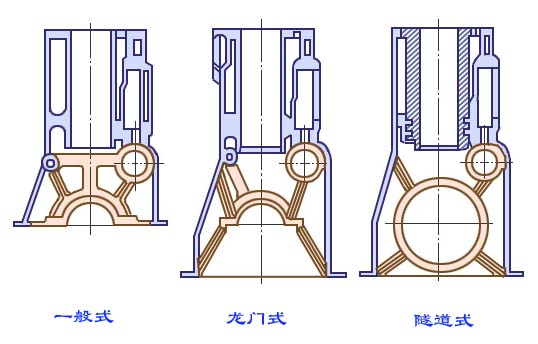
(1) General cylinder block is characterized in that the oil pan installation plane and the crankshaft rotation center are at the same height. This cylinder block has the advantages of small height, light weight, compact structure, easy processing, and easy installation and disassembly of the crankshaft; however, its disadvantage is poor rigidity and strength.
(2) The gantry type cylinder block is characterized in that the installation plane of the oil pan is lower than the rotation center of the crankshaft. It has the advantages of good strength and rigidity, and can withstand large mechanical loads; but its disadvantages are poor processability, heavy structure, and difficult processing.
(3) Tunnel type cylinder block This type of cylinder block crankshaft main bearing hole is an integral type, using rolling bearings, the main bearing hole is larger, the crankshaft is loaded from the rear of the cylinder block. Its advantages are compact structure, good rigidity and strength, but its disadvantages are high processing precision, poor processability, and inconvenient disassembly of the crankshaft.
In order to enable the inner surface of the cylinder to work normally at high temperatures, the cylinder and cylinder head must be properly cooled. There are two cooling methods, one is water cooling and the other is air cooling (Figure 2-3). The cooling water jacket is formed around the cylinder of the water-cooled engine and in the cylinder head, and the cylinder block communicates with the cooling jacket of the cylinder head. The cooling water continuously circulates within the water jacket, taking away some of the heat and cooling the cylinder and cylinder head. 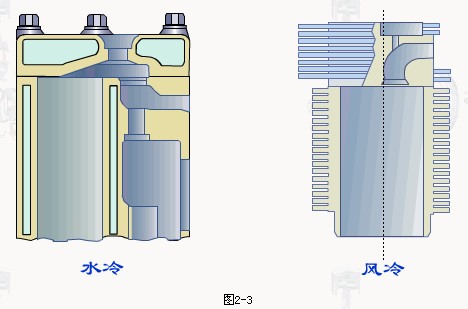
Modern garbage sweepers basically use water-cooled multi-cylinder engines. For multi-cylinder engines, the arrangement of cylinders determines the size and structural characteristics of the engine. It also affects the stiffness and strength of the garbage sweeper engine block and relates to garbage sweeping. The overall layout of the car. According to the arrangement of the cylinders, the cylinder block can also be divided into single-row type, V-type and opposite type (Figure 2-4).
(1) Inline 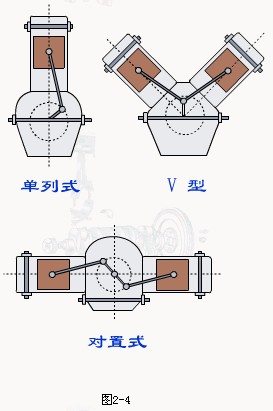
The cylinders of the engine are arranged in a row and are generally arranged vertically. The single-row cylinder block has a simple structure and is easy to process, but the length and height of the engine are relatively large. Generally, the following six-cylinder engines use single-column type. For example, the engines used in the Jetta sedans, the Fukang sedans and the Hongqi sedans all use this in-line cylinder block. Some garbage sweepers tilt the engine at an angle to reduce the height of the engine.
(2) Type V
The cylinders are arranged in two rows. The included angle γ<180° between the left and right two cylinders is called a V-type engine. Compared with the in-line engine, the V-type engine shortens the length and height of the airframe, and increases the rigidity of the cylinder body, reducing the The weight of the engine, but increased the width of the engine, and the shape is more complex, processing difficulties, generally used for more than 8 cylinders of the engine, 6-cylinder engine also uses this form of cylinder block.
(3) Opposite
The cylinders are arranged in two rows and the two cylinders on the left and right are on the same horizontal plane, that is, the included angle between the left and right two columns of the cylinder centerline is γ=180°, which is called opposite type. It is characterized by its small height, convenient overall layout, and favorable air cooling. This cylinder is less applied. 
The cylinder is directly attached to the cylinder block and is called an integral cylinder. The integral cylinder has good strength and rigidity and can withstand large loads. Such cylinders require high materials and high costs. If the cylinder is manufactured as a separate cylindrical part (ie cylinder liner), it is then loaded into the cylinder block. In this way, the cylinder liner is made of high-quality, wear-resistant materials, and the cylinder block can be manufactured from less expensive general materials, thereby reducing manufacturing costs. At the same time, the cylinder liner can be removed from the cylinder block, which facilitates repair and replacement, and can greatly extend the life of the cylinder block. Cylinder sleeves are dry cylinder liners and wet cylinder liners (Figure 2-5).
Dry cylinder liner is characterized by the cylinder set into the cylinder block, the outer wall is not in direct contact with the cooling water, and the cylinder body wall directly contact, thin wall thickness, generally 1 ~ 3mm. It has the advantages of an integral cylinder block, and its strength and rigidity are good, but the processing is more complicated. The inner and outer surfaces need to be finished, and it is inconvenient to disassemble and disassemble, resulting in poor heat dissipation.
Wet cylinder liner is characterized by the cylinder set into the cylinder block, the outer wall directly with the cooling water contact, the cylinder sleeve only in the upper and lower have a ring and cylinder block contact, the wall thickness is generally 5 ~ 9mm. It has good heat dissipation, cooling uniformity, easy processing, usually only needs finishing the inner surface, and the outer surface in contact with water does not need to be processed, convenient disassembly and assembly, but the disadvantage is that the strength and rigidity are not as good as the dry cylinder liner, and easy to produce Water leakage phenomenon. Some leakage prevention measures should be taken.
The part of the lower part of the cylinder block of the garbage sweeper used to install the crankshaft is called a crankcase, and the crankcase is divided into a crankcase and a lower crankcase. The upper crankcase is integrated with the cylinder block, the lower crankcase is used for storing the lubricating oil, and the upper crankcase is closed, so it is also referred to as the oil pan diagram (Fig. 2-6). The oil pan has a small force and is generally stamped and formed from sheet steel. Its shape depends on the overall layout of the engine and the capacity of the oil. The oil pan is equipped with a stable oil baffle to prevent the oil surface from fluctuating excessively when the rubbish sweeper is shaken. Oil drain plugs are also installed on the bottom of the oil pan. Usually, permanent magnets are installed on the oil drain plugs to absorb the metal shavings in the oil and reduce engine wear. Pads are installed between the upper and lower crankcase joint surfaces to prevent oil leakage. 
The cylinder head is mounted on the cylinder block and seals the cylinder from above and forms a combustion chamber. It is often in contact with high-temperature, high-pressure gas, and therefore it is subject to large thermal and mechanical loads. The cooling jacket is formed inside the cylinder head of the water-cooled engine, and the cooling water hole at the lower end face of the cylinder head communicates with the cooling water hole of the cylinder block. Recycled water is used to cool the high temperature parts such as the combustion chamber. 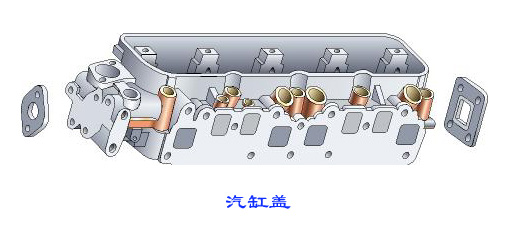
The cylinder head is also equipped with intake and exhaust valve seats, valve guide hole for the installation of intake and exhaust valves, and intake and exhaust passages. The cylinder head of the gasoline engine is machined with holes for spark plugs, while the cylinder heads of diesel engines are machined with holes for injectors. The camshaft bearing holes are also machined on the cylinder head of the overhead camshaft engine to mount the camshaft.
Figure 2-7
The cylinder head is generally cast from gray cast iron or alloy cast iron. The heat conductivity of the aluminum alloy is good, which helps to improve the compression ratio. Therefore, the aluminum alloy cylinder head has been used more and more in recent years.
The cylinder head is an integral part of the combustion chamber. The shape of the combustion chamber has a great influence on the operation of the engine. Due to the difference in the combustion modes of the gasoline engine and the diesel engine, the parts of the cylinder head that make up the combustion chamber differ greatly. The combustion chamber of the gasoline engine is mainly on the cylinder head, and the combustion chamber of the diesel engine is mainly in the pit on the top of the piston. Here only the combustion chamber of the gasoline engine is introduced, and the combustion chamber of the diesel engine is introduced in the diesel supply system.
There are three common forms of gasoline engine combustion chambers (Figure 2-8). 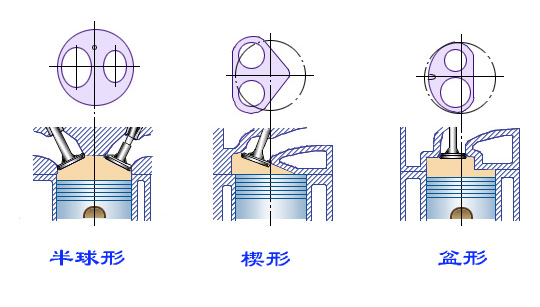
(1) Hemispherical combustion chamber
The hemispherical combustion chamber has a compact structure, the spark plug is arranged in the center of the combustion chamber, and the flame stroke is short, so the combustion rate is high, the heat dissipation is low, and the thermal efficiency is high. The structure of the combustion chamber also allows the valves to be arranged in double rows and the inlet diameter is large, so the gas filling efficiency is high. Although the gas distribution mechanism becomes more complex, it is beneficial to the purification of exhaust gas and is widely used in passenger cars. application.
(2) Wedge combustion chamber
The wedge-shaped combustion chamber has a simple and compact structure, a small heat-dissipation area and a small heat loss, and can ensure that the mixture gas forms a good swirling motion during the compression stroke, which is beneficial to increase the mixing quality of the mixture gas, has a small intake resistance, and improves the charging efficiency. The valves are arranged in a row and the valve train is simple, but the spark plugs are placed high in the wedge combustion chamber and the flame travels longer. The Cherokee sedan engine uses this type of combustion chamber.
(3) Pan-shaped combustion chamber
In the basin-shaped combustion chamber, the cylinder head is of good craftsmanship and low in manufacturing cost. However, because the valve diameter is easily limited, the intake and exhaust effects are worse than that of the hemispherical combustion chamber. Jetta sedan engine, Audi sedan engine with a basin-shaped combustion chamber. 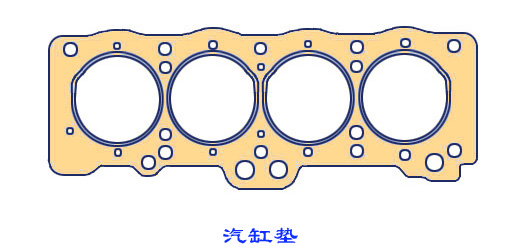
The cylinder gasket is installed between the cylinder head and the cylinder block, and its function is to ensure the sealing of the contact surface between the cylinder head and the cylinder block to prevent air leakage, water leakage and oil leakage.
The material of the cylinder head pad must have certain elasticity, can compensate the unevenness of the joint surface to ensure sealing, and at the same time, it must have good heat resistance and pressure resistance, and it should not burn or deform under high temperature and high pressure. At present, more applications are copper cylinder-cotton structure cylinder head gaskets. Because there are three copper skins at the flange of the copper skin-cotton cylinder pad, it is less deformable than the asbestos during compression. Some engines also use a braided steel screen or perforated steel plate as the skeleton in the asbestos center, and cylinder gaskets pressed on both sides with asbestos and rubber adhesives.
When installing the cylinder head gasket, first check the quality and integrity of the cylinder head gasket. All holes in the cylinder head gasket should be aligned with the holes in the cylinder block. Secondly, the cylinder head bolts must be properly tightened according to the requirements of the garbage sweeper manual. When tightening the cylinder head bolt, it must be carried out two to three times from the center symmetrically to the surrounding area, and tightened to the specified torque the last time.
Hubei Chusheng Graphic Garbage Sweeper Engine Structure Principle